Introduction
Globalization is the broad outline of the places where most of humanity now chooses to live and work-cities. These cities are the engines of growth for their countries and gateway to the resources of their regions. They are the biggest; most interconnected cities help set global agendas, weather transnational dangers, and serve as the hubs of global integration. In many ways, the story of globalization is the story of urbanization.
Local governments are becoming increasingly involved in local economic development programs: government-supported programs that seek to increase local jobs or the local tax base by measures such as assisting individual businesses. City development is increasingly gaining importance because cities support a lot of population indirectly and have to support the ‘transitory population’ which is the population that moves into the city during day hours for business and work purposes.
New York City has been announced as “The Best City To Do Business” in the 2008 Global Cities Index.New York emerged as the No. 1 global city in 2008, followed by London, Paris, and Tokyo. New York beats other global cities largely on the back of its financial markets, through the networks of its multinationals, and by the strength of its diverse creative class. Overall runner-up London won the cultural dimension by a mile. (Foreign Policy Website, 2008) This Index ranks cities based on 24 metrics across five dimensions for their metro areas. Some of the metrics used are:
- Business activity: includes the value of its capital markets, the number of Fortune Global 500 firms headquartered there, and the volume of the goods that pass through the city.
- The second dimension measures human capital, or how well the city acts as a magnet for diverse groups of people and talent. This includes the size of a city’s immigrant population, the number of international schools, and the percentage of residents with university degrees.
- The third dimension is information exchange—how well news and information are dispersed about and to the rest of the world. The number of international news bureaus, the amount of international news in the leading local papers, and the number of broadband subscribers round out that dimension.
- The fourth is a cultural experience or the level of diverse attractions for international residents and travelers. That includes everything from how many major sporting events a city hosts to the number of performing arts venues it boasts. The final dimension— political engagement—measures the degree to which a city influences global policymaking and dialogue. By examining the number of embassies and consulates, major think tanks, international organizations, sister city relationships, and political conferences a city hosts.
There are several factors which determine that city inhabitants have had a significant role in local economic development decisions like:
- Disposable income of the residents
- Skilled workforce/ manpower
- Repute/good educational institutes
- Better infrastructure(communication network, transportation facility)
- Cultural experience(diverse attractions for international residents and travelers)
An important variable to measure the impact of the economic state is the disposable income of the residents. Disposable income reflects two points. The first being the fact that the per capita income is high and the second is that the propensity to save is high due to low-cost factors or saving habits of the residents. High disposable income ensures that the avenues for both production and consumption remain high. High disposable income can be used to either accumulate funds in banks/investment instruments or reinvest the resources in business.
Socio-Economic status is another important and useful variable. The first strong empirical evidence that socio-economic status was a powerful predictor of education outcomes was presented some forty years ago, although the belief that poverty affected educational outcomes is much older than that. Still, forty years later, socio-economic status remains the single most powerful predictor not just of education but of all life outcomes (Levin, 2006).
This paper examines the hypothesis that strong local economic health heightens the role played by local residents in economic development decision making. To do so the economic indicators have been analyzed for the selected cities through use of published materials and available databases.
Methods
The cities of London and New York are both well-developed urban agglomerations that have a robust urban planning and execution system behind them. The local governance ensures citizen partnership and this, in turn, ensures that the citizens are cooperative in program deployment and execution.
The local economic development is affected by local government activities. However, local economic development policy is usually defined more narrowly as special activities, undertaken by public or private groups, to promote economic development. The activities labeled “economic development programs” fall into two categories:
- Providing customized assistance targeted at individual businesses that are thought to provide greater economic development benefits; and
- Strategic initiatives in which more general tax, spending, and regulatory policies of government are changed to promote local economic development.
One of the key findings of this study is the fact that when the disposable income rises, the participation of the locals rises in the economy by ways of more employment or business. One of London’s greatest strengths is the diversity of its business community. The diversity of business helps the city to sustain economic cycles and this is one primary reason that the overall development does not take too much beating even when the market is slow or dipping.
Citizen participation can be identified or reckoned in various ways. Even the act of tax payment or abiding by rules qualifies as participation. Citizen participation can be ensured by marking out the importance and gains that pertain to it. This works only till the gains are visible and become obvious. All the intangible, as well as the tangible, should be highlighted. This recognition motivates the citizens further to participate in the process. These things remain undermined and provide maximum leverage to the efforts. (www.ohioline.osu.edu)
Volunteer groups function as links between individuals and larger societal structures (Bellah et al. 1985, Kornhauser 1959). Bridges (1974) cites five advantages to be gained from the active participation of the citizens in community affairs:
- The individual learns the process of making desired changes.
- Citizens get a chance to bring about desired change by being expressive of their desire, either individually or through a community group.
- The citizen learns to understand and appreciate the individual needs and interests of all community groups.
- The dynamics of group as it applies to mixed groups is appreciated and understood by the individuals.
- The citizen learns how to resolve conflicting interests for the general welfare of the group.
In cases when the economy has strong economic health, individuals have higher disposable income and hence the basic economic rule of demand and supply plays in the economy and they start controlling economic decisions through altering their spending behavior. Also, the decisions to invest in new projects do change the economic decisions. If a new trade zone is being promoted by a growing city’s commerce council the political decision-makers in most cases back the decision by formulating supportive rules. Such investments also draw in substantial employment generation and the multiplier effect sets in. this makes the investors more conscious of pushing forward for favorable economic laws
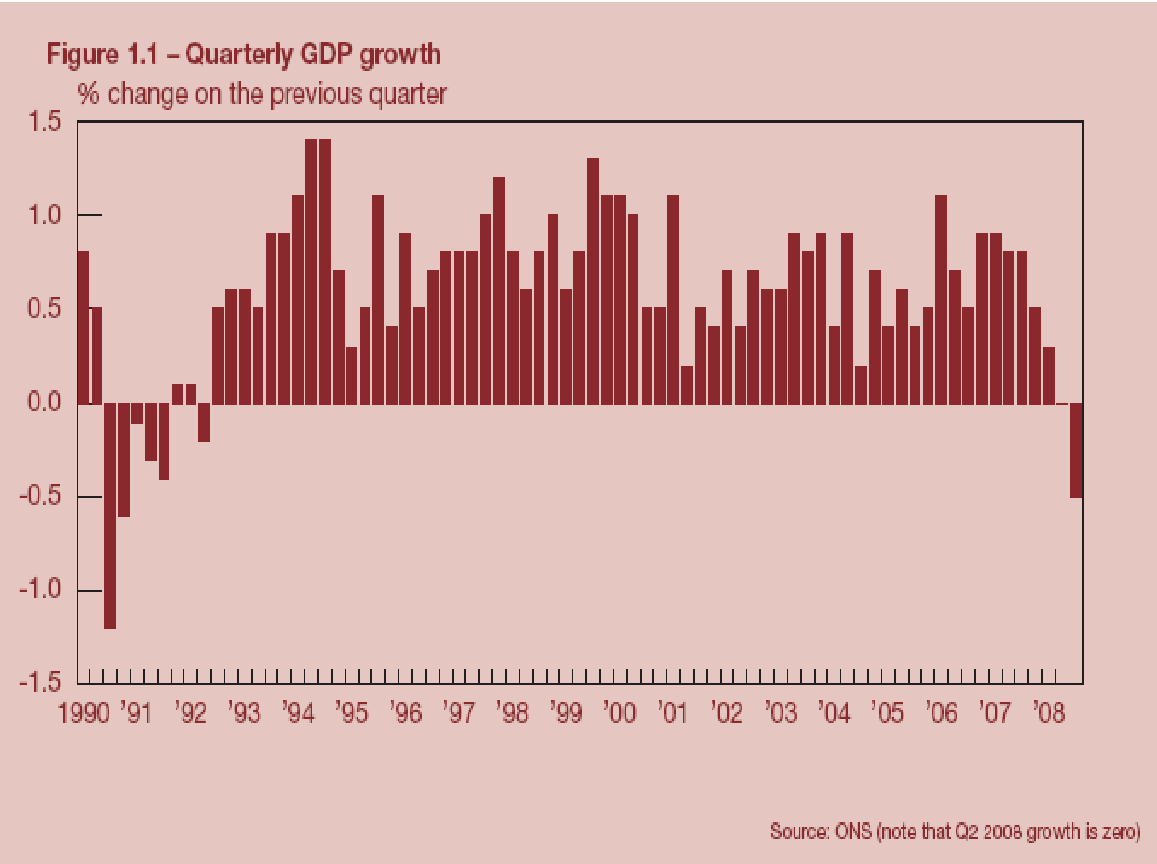
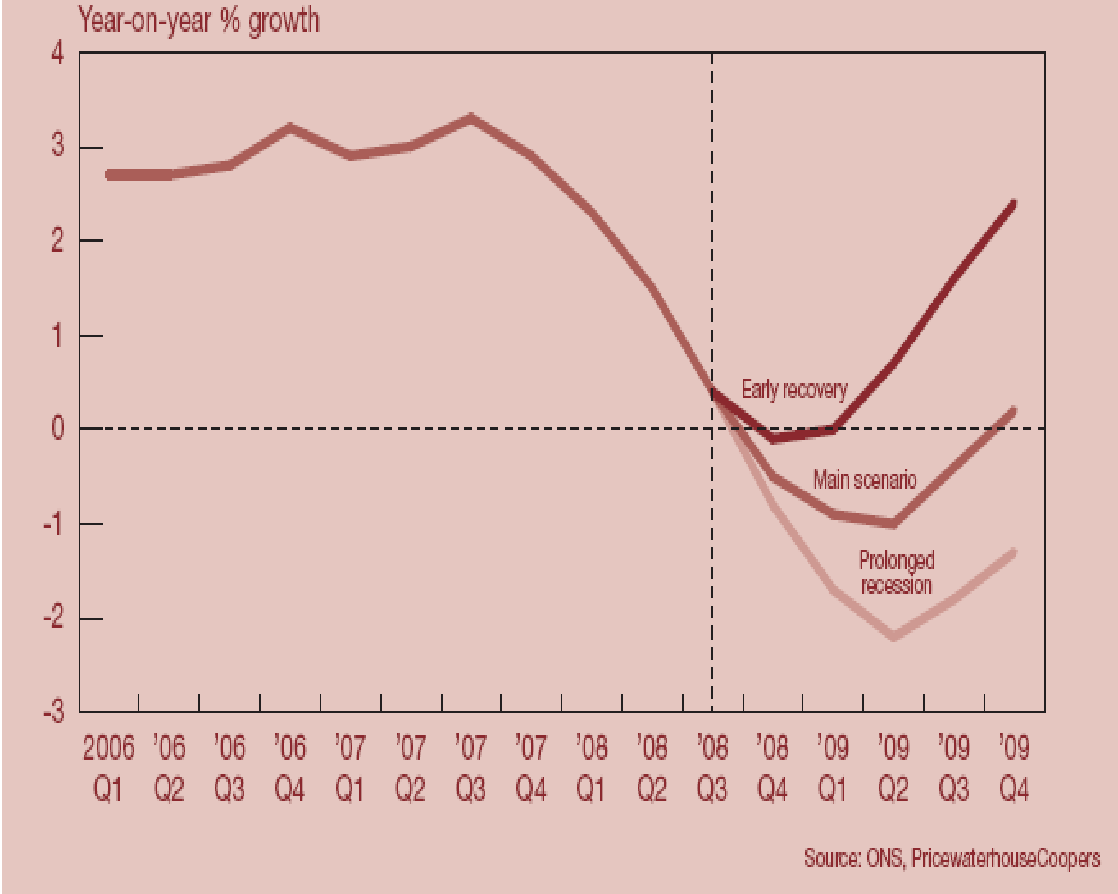
The two figures show the dipping economic scenario and projected recovery path if initiated during the current global turmoil. Thus while the scenario has been pretty static and healthy, the current year has made the scenario quite gloomy. In such cases the business community too loses motivation to play in the market and it wears off their interest to get the laws affected.
The sectoral growth trends also show a similar pattern which the major sectors taking most of the beating. The manufacturing sector which has the major share of economic reliability for the economy has dropped very significantly. In such cases, disposable income falls and people start losing grounds with the administration.
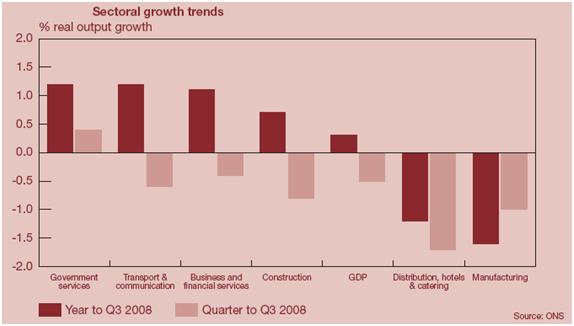
The second table shows some key economic variables for the economy. It also shows how he motivation to save and spend lose motivation when the economy reels under pressure.
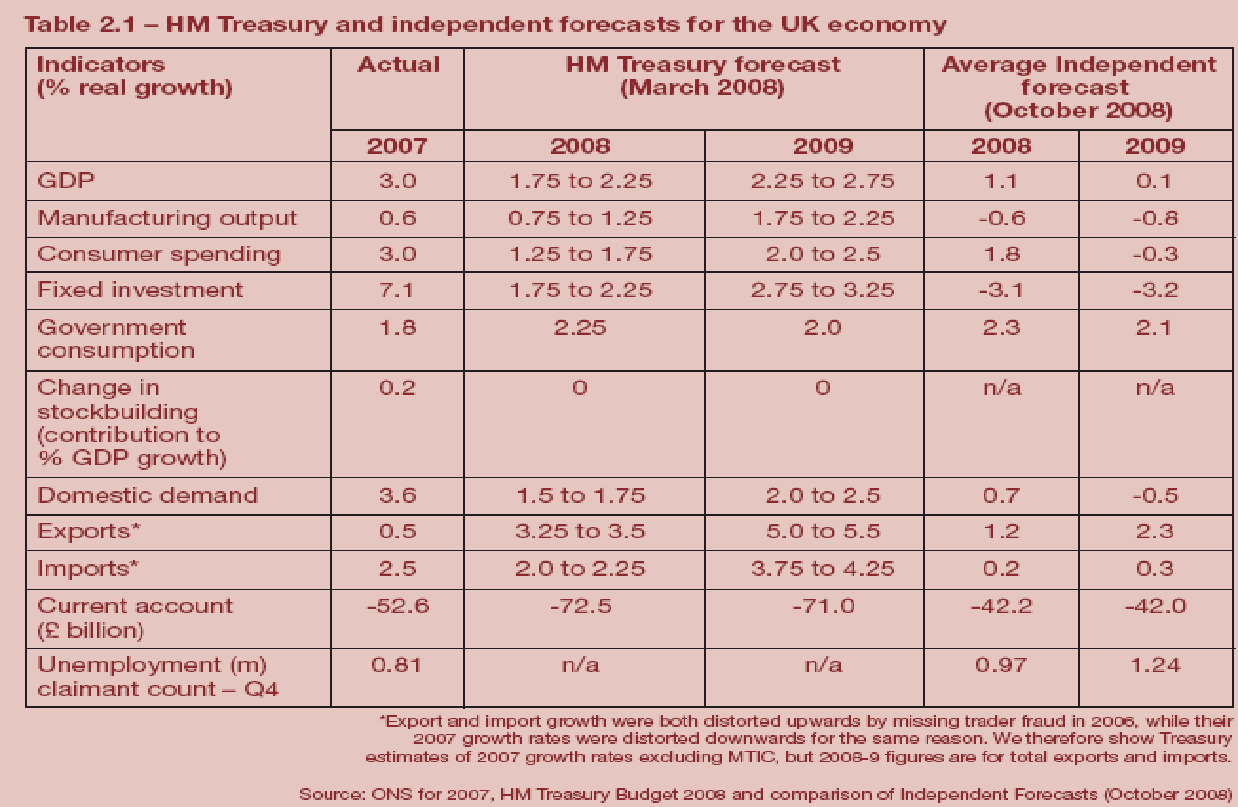
Analysis
London’s largest sector is the manufacturing industry, employing over 38,000 people, or 16% of the overall workforce. (London Economic Development Corporation) The chart below shows the full breakdown of employment by industry category.
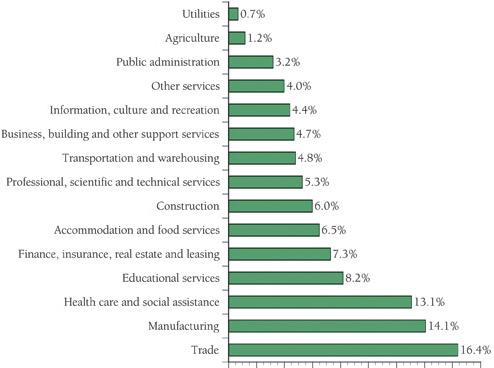
The key demographical indicators of the city of London are as follows:
As we observe from the table; the workforce is a healthy 61% of the population. This means that the earning members are a major portion of the population while a relatively sizeable aging population indicates good health and social state.
In comparison, the city of New York has some comparative similarities while demonstrating some differences from London. The monthly data released by the Manhattan Chamber of Commerce for November 2008 report some key traits about New York City. (www.manhattancc.org/common) These facts also reveal the economic health of the economy.
- Private Employment fell by 3,400 jobs in September, after an increase of 1,900 jobs in August.
- The unemployment rate remained at 5.8 percent in September.
- The Manhattan hotel occupancy rate in September 2008 was 85.7 percent, down from 86.7 percent in September 2007.
- Passengers in NYC area airports totaled 10.5 million in August 2008, down 2.2 percent from August 2007.
As per the same report the city also reported an increased unemployment rate over the last year for the same period:
The demographic indicators point that here too the male-female skew is the same as in London. The population in the age group 19-65 here is almost the same as in London. (US Census Bureau, 2008)
Local economic development programs are often politically controversial because they involve government assistance to individual businesses, which may be perceived by political liberals as “corporate welfare” and by political conservatives as unwarranted government interference with the private sector. Such ideological issues help motivate citizen oppositions to economic development policies, which is often a major barrier to successful local economic development policies. On the other hand, local economic development programs often seem difficult to constrain: once the government is supporting a few individual businesses, how do local government managers rationalize saying no to requests for support from other businesses? Local government managers need to encourage coming to a local consensus about appropriate goals of economic development policies. An agreement about the selected goals provides a basis for deciding what local economic development efforts should and shouldn’t do be implemented.
Though the manes and geographies change; the most successful global cities have several things in common: global cities are those that excel across multiple dimensions. Even Shanghai’s staggering, decades-long double-digit annual economic growth alone can’t make it global. The city also must determine how to use that wealth to influence policy, attract the brightest young minds, and accurately portray the rest of the world to its citizens. Global cities continuously adapt to changing circumstances. London may be the city hardest hit by the global credit crunch, but chances are that it will leverage its abundant global financial ties to bounce back.
Conclusions
A paper on the best available summary of models for analyzing the economic and fiscal impact of new business on a local economy is provided by a 1999 report, Evaluating Incentives. (Poole, 1999) Any model of economic, employment and fiscal impacts of new businesses must combine economic theory about local economies with area-specific information about the particular supplier linkages in the area. Two of the most prominent “economic impact” models–which provide estimates of effects of a new plant on area production and income, are the IMPLAN model and the REMI model. The results from economic impact models can then be used in a “fiscal impact” model. (www.upjohninst.org).
The hypothesis that a strong local economic health heightens the role played by residents in economic development decision making is accepted and it further comes out that citizens will voluntarily participate in a community activity when they:
- Find some relevant positive benefits.
- Get an appropriate organizational structure to express their interests.
- See some aspect of their way-of-life threatened. (Kotter’s 8-Stage Change Model also expresses this) (www.au.af.mil)
- Feel committed to be supportive of the activity.
- Have better knowledge of an issue or situation.
- Feel comfortable in the group.
One more important thing that usually is observed by overlooked is the cultural differences that exist in such cases. The cultural differences between the nations too affect the way people interact in the whole process of governance and communicating their stances. Even after factoring in such differences, it is observed that the role of individuals in affecting economic decisions increases when economic development is better off.
This study took into view two major cities in two developed economies so the economic condition’s disparity is negated out. In case a further study is carried out on similar lines to explore the increasing role of citizens to change economic rules in growing economies; the robustness of this hypothesis’s validity would be better tested. It is a well-known fact that cultural differences do affect the preferences of people and hence any such change due to the geographical change of the study should be studied.
The economic scenario is changing and businesses are becoming more responsible and appreciating citizen’s concerns on issues like environment (www.pwc.com). This also makes us understand how impactful is the force of citizens in changing and affecting decisions. Proper communication ensures more citizen participation and response. Wulflhorst and Mancl (1990) summarized a sewage facility controversy in Pennsylvania where lack of communication causes issues. Wright and Hyman (1966) examined data from two surveys conducted by the National Opinion Research Center. Their findings note that membership in voluntary associations is not a characteristic of most Americans. This situation proves that though the participation to change in local economic laws may be higher than other’s certain other factors also affect this phenomenon and need further study.
References
Bartik. Timothy J. (2003) UPJohn Institute for employment Research. Local Economic Development Policies.
Citizen Participation In Community Development (2008). Ohio State University Fact Sheet.
Foreign Policy Website, (2008).The 2008 Global Cities Index, Web.
Poole Kenneth, Erickcek George, Iannone Donald, McCrea Nancy, and Pofen Salem, Evaluating Business Development Incentives (Washington, DC: National Association of State Development Agencies, (1999)
Kornhauser, A., (1959) The Politics of Mass Society. New York: The Free Press.
Manhattan Chamber of Commerce, (2008). Economic Snapshot – A Summary of New York City’s Economy.
Persons, 1984. Babchuk N. and A. Booth, (1969) Voluntary Association Membership: A Longitudinal Analysis. American Sociological Review, 34 (P 31-45)
Levin, B. (2005). A history of urban education in Winnipeg. Paper presented to the Canadian Society for the Study of Education, London, Ontario.
London Economic Development Corporation (LEDC), Real Estate Sales.
London Economic Development Corporation (LEDC), Demographics.
Price WaterHouse Coopers, (2008) UK Economic Outlook.
Price WaterHouse Coopers, (2008) UK Economic Outlook.
Price WaterHouse Coopers, (2008) The world in 2050.
USAF Academy Cadet Site (2008). USAF Academy cadet review of the book “Leading Change”
US Census Bureau, (2008). New York City Key Statistics.
Wright, Charles R. and Hyman, Herbert H., (1966) Voluntary Association Memberships of American Adults: Evidence from National Sample Surveys. Perspectives on the American Community, Roland L. Warren (ed.), Chicago: Rand McNally.
WulDhorst, Peter and Karen Mancl, (1990) Community Decisionmaking in Providing Sewer Service to a Rural Area. The Environmental Professional, Vol. 12 pp. 156163.